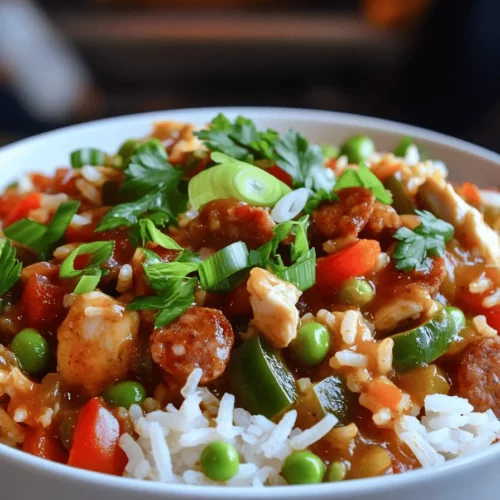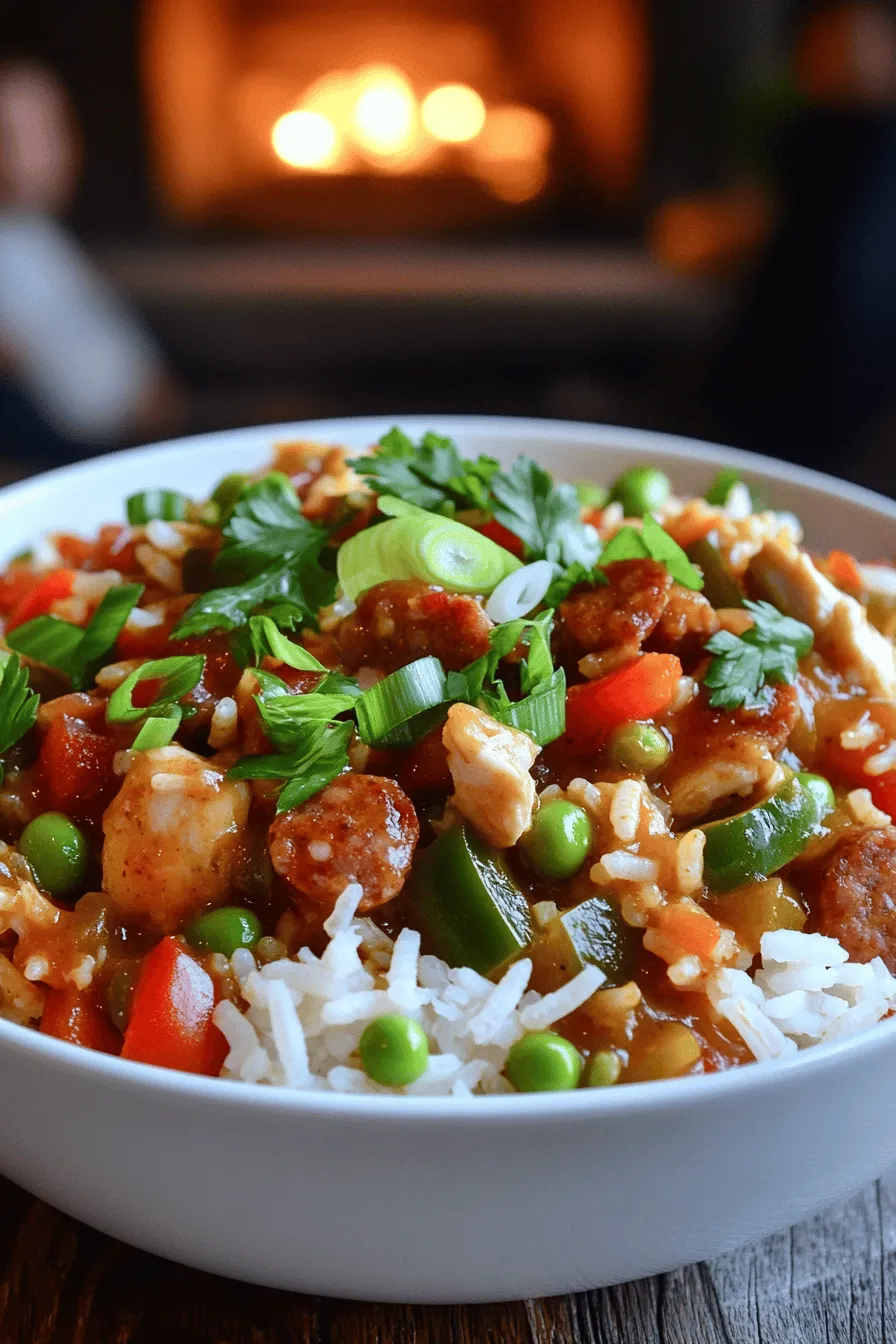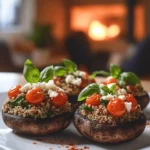Looking for a dinner that’s both simple and bursting with flavor? You’ve found it! Jambalaya is a one-pot wonder that combines rice, protein, and spices into a hearty meal. Whether you’re cooking for your family or hosting friends, this dish is sure to impress. In this article, I’ll share key ingredients, cooking tips, and fun variations to make your jambalaya unforgettable. Let’s dive in and discover how to create this delicious dish!
What Are the Key Ingredients for a Perfect Jambalaya?
To make a great jambalaya, you need some key ingredients. Let’s break down what you need to create this dish.
What Main Ingredients Do You Need for Jambalaya?
The main ingredients for jambalaya include meats, rice, and broth. I like to use andouille sausage and chicken. The sausage brings spice, and the chicken adds flavor. You will also need long-grain rice. This rice cooks well and stays fluffy. For the broth, chicken broth is best. It gives your jambalaya a rich taste.
Are There Essential Spices for Flavor in Jambalaya?
Spices are very important in jambalaya. I always add Creole seasoning for that classic Southern taste. Smoked paprika gives a nice depth to the dish. Dried thyme adds a subtle earthiness. Don’t forget the bay leaf! It enhances the aroma. Salt and black pepper round out the flavors. These spices create a warm and inviting dish that everyone loves.
How Do Vegetables Enhance the Jambalaya Recipe?
Vegetables play a big role in jambalaya. Onion, bell pepper, and celery form the “holy trinity” of Cajun cooking. They add flavor and texture. Garlic boosts the taste even more. Adding vegetables like peas at the end brings freshness. They add a pop of color too. This mix of veggies makes the dish balanced and tasty.
For the full recipe, check out the Spicy Creole Jambalaya . It is a simple and delightful dinner that your family will enjoy.
How Do You Cook Jambalaya Like a Pro?
To cook jambalaya like a pro, start with the right method. The best cooking method is the one-pot technique. This method lets all the flavors blend together. It saves time and makes cleanup easy.
What is the Best Cooking Method for Jambalaya?
The one-pot method works well for jambalaya. You can cook all your ingredients in one large pot. First, you brown the meat. Then, you add the vegetables and rice. Finally, you pour in the broth and let it simmer. This keeps the dish flavorful and moist.
What Cooking Techniques Ensure Perfectly Cooked Rice in Jambalaya?
Perfectly cooked rice is key to great jambalaya. You should rinse the rice before cooking. This removes excess starch and helps it cook evenly. When you add rice to the pot, let it toast for a couple of minutes. This adds a nutty flavor. After you add the broth, do not lift the lid while it simmers. This helps the rice absorb all the liquid.
What Tips Can Help Beginners Master Cooking Jambalaya?
For beginners, start with simple ingredients. The recipe I use includes chicken and andouille sausage. These meats add great taste. Don’t be afraid to adjust the spices to your liking. Use Creole seasoning for a kick. If you want extra flavor, try smoked paprika. Always taste as you go. This helps you learn what flavors work well together. For a great finish, fluff the jambalaya with a fork before serving.
If you want to try making this dish, check out the Full Recipe for a detailed guide.
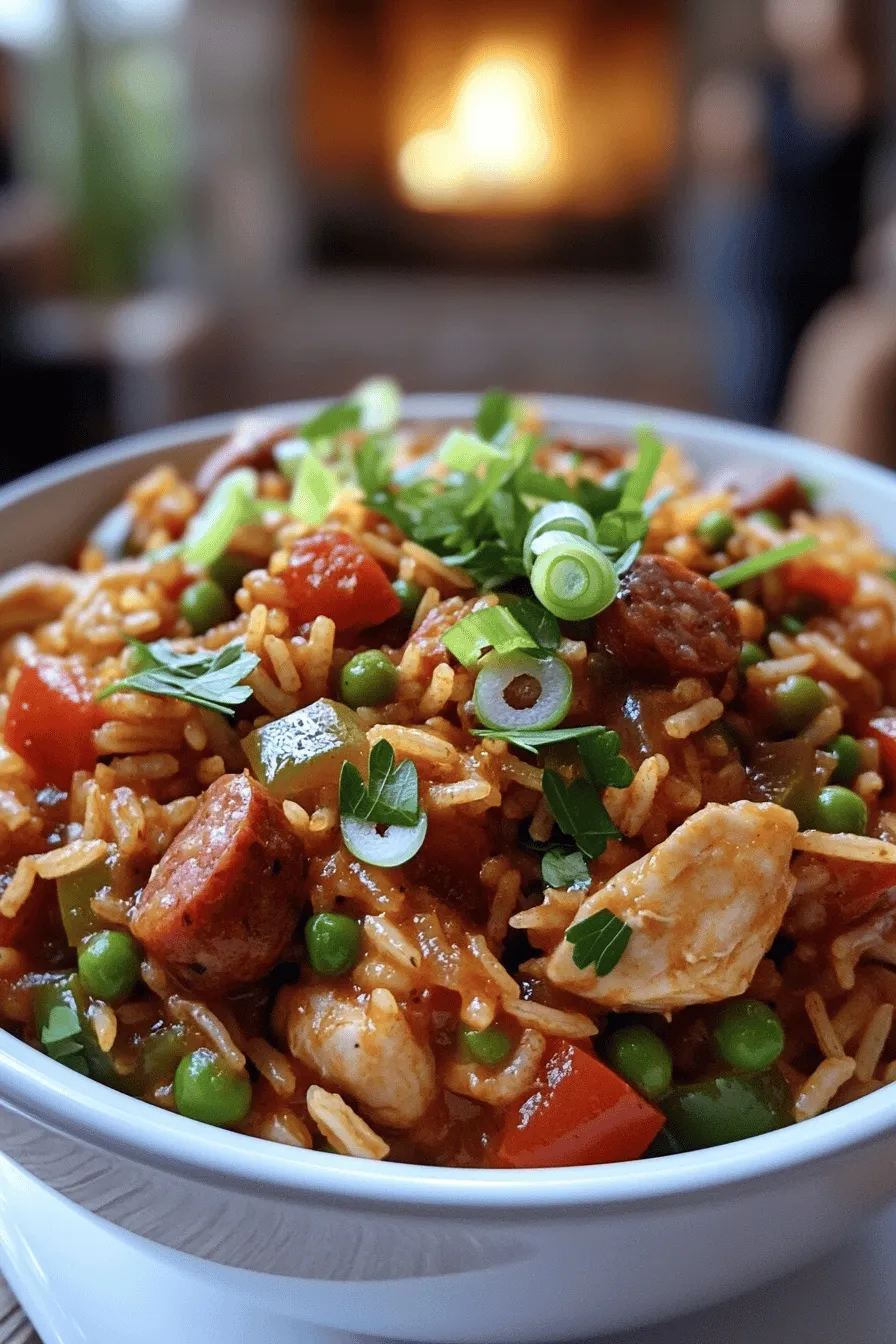
What Are the Popular Variations of Jambalaya?
Jambalaya has many fun variations. Each type offers its own unique taste. The most common types are chicken jambalaya, seafood jambalaya, spicy jambalaya, and vegetarian jambalaya.
What Are the Differences Between Cajun and Creole Jambalaya?
Cajun and Creole jambalaya differ mainly in ingredients. Cajun jambalaya uses a mix of meats like chicken and sausage. It often has a smoky flavor. Creole jambalaya includes tomatoes and seafood. This gives it a richer taste and a vibrant color. Both styles are delicious but reflect different cultures.
How Can You Make a Delicious Seafood Jambalaya?
To make a tasty seafood jambalaya, start with fresh or frozen seafood. Shrimp, fish, and mussels work well. Use a base similar to the spicy Creole jambalaya recipe. Replace chicken and sausage with seafood. Add the seafood towards the end of cooking. This keeps it tender and juicy.
What Are Some Unique Vegetarian and Vegan Jambalaya Ideas?
Vegetarian jambalaya can be just as flavorful. Use vegetables like bell peppers, zucchini, and corn. You can add beans for protein and texture. For a vegan twist, skip the chicken broth and use vegetable broth instead. This keeps your dish hearty and satisfying. You can use the full recipe to guide you in making these variations.
What Makes Jambalaya Unique Compared to Other Dishes?
Jambalaya stands out for its rich blend of flavors and history. It mixes rice with meats, seafood, and spices. This mix creates a dish that is both hearty and satisfying. Many people wonder, how does jambalaya compare to Spanish paella?
Jambalaya differs from paella in a few key ways. First, jambalaya uses long-grain rice, while paella often uses short-grain rice. Second, jambalaya has a meat-focused base, usually with chicken and sausage. Paella, on the other hand, often centers on seafood. Lastly, the spices vary. Jambalaya leans on Creole seasoning, while paella uses saffron for its unique taste.
Now, let’s explore the historical significance of jambalaya in Creole cuisine. Jambalaya has roots in Louisiana, blending French, Spanish, and African flavors. The dish likely emerged in the 18th century. It reflects the melting pot of cultures in New Orleans. Each chef adds their own twist, making it a personal creation for many.
The flavor profiles in jambalaya can change by region. In New Orleans, the dish is often spicy and rich, with lots of smoked sausage. In contrast, Cajun jambalaya may focus more on the heat from peppers. Some recipes add shrimp or fish for a coastal flavor, while others highlight vegetables for a lighter dish.
Jambalaya is more than a meal; it’s a celebration of culture. You can find many variations, but the heart of the dish remains the same. If you want to try making this dish, check out the Full Recipe for a delicious experience. Enjoy every bite!
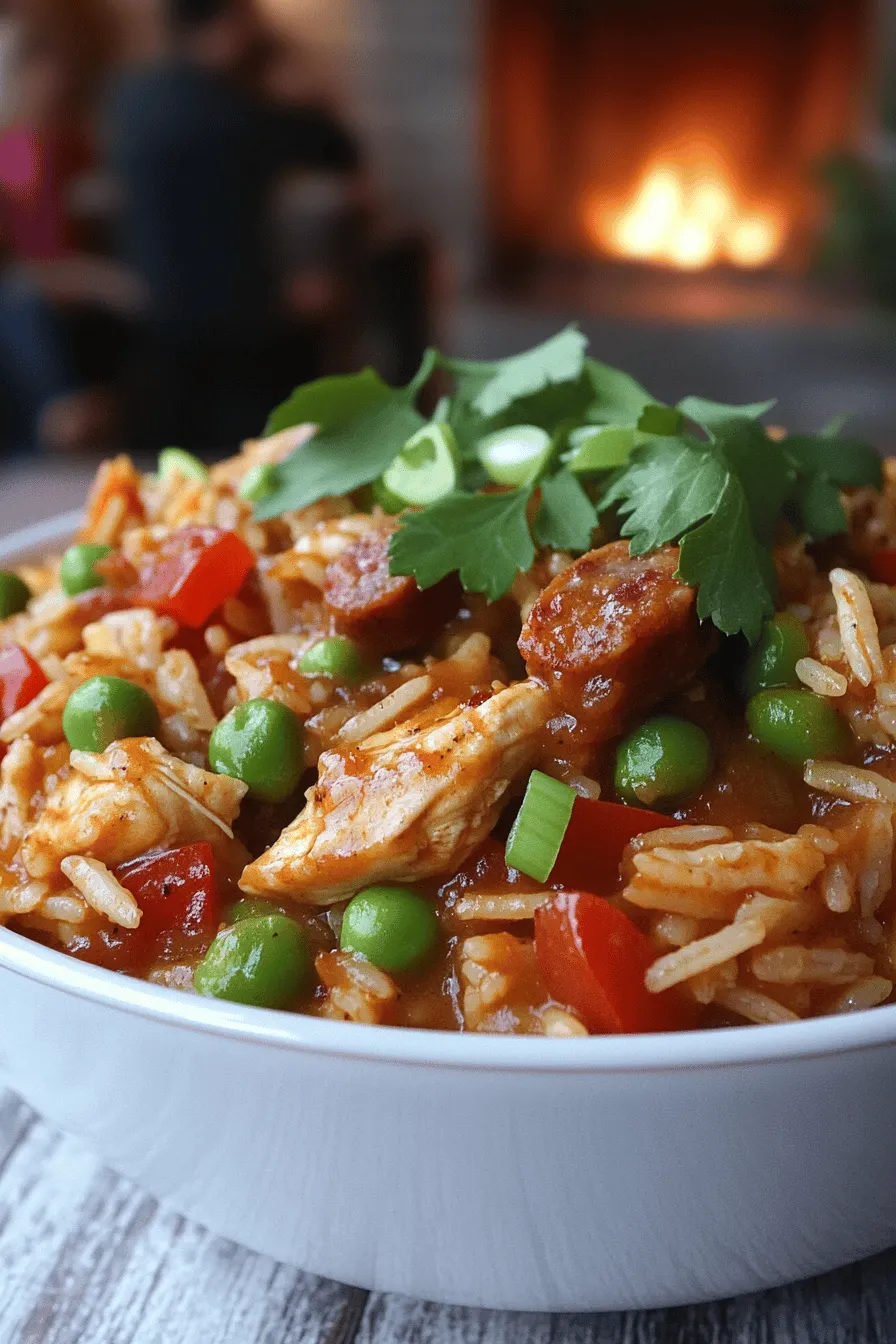
What Are Common Serving Suggestions for Jambalaya?
Jambalaya is a hearty dish that shines on its own. Still, you can enhance it with sides and garnishes.
What Are the Best Side Dishes to Serve with Jambalaya?
Some great sides for jambalaya include crusty French bread or cornbread. A simple green salad adds freshness. You can also serve coleslaw, which gives a nice crunch. Pickled vegetables can add a tangy touch too. Each of these sides balances the rich flavors of your jambalaya.
What Simple Garnishes Can Enhance Your Jambalaya Presentation?
Garnishes make your dish look great. Chopped green onions and parsley add color. A slice of lime can bring a zesty kick. If you like spice, add a few slices of fresh jalapeño. These small touches make your jambalaya more inviting.
How Can You Prepare Jambalaya for Large Gatherings or Celebrations?
To serve jambalaya at a party, make a big batch. This dish tastes even better as it sits. Use a large pot or a slow cooker. Keep it warm until it’s time to eat. Serve in bowls, or let guests scoop their own. This way, everyone can enjoy a tasty meal.
For the full recipe, check out my Spicy Creole Jambalaya. Enjoy your cooking!
How Can You Prepare Jambalaya in Advance?
To make jambalaya ahead of time, start by cooking it fully. Follow the full recipe to achieve the best taste. After cooking, let it cool to room temperature. Avoid putting hot food directly in the fridge. This helps maintain the quality of your dish.
Once cooled, transfer jambalaya to an airtight container. Make sure to press out any excess air. You can store it in the fridge for up to three days. If you need longer storage, freeze the jambalaya. It can stay good in the freezer for up to three months.
What Are the Steps for Preparing Jambalaya Ahead of Time?
1. Cook the Jambalaya: Use the full recipe to prepare your dish.
2. Cool It Down: Allow it to cool completely before storing.
3. Store Properly: Place it in airtight containers for the fridge or freezer.
4. Label and Date: Write the date on the container to keep track of freshness.
These steps ensure your jambalaya stays tasty and safe to eat later.
How Should You Store and Reheat Jambalaya Leftovers?
For leftovers, store jambalaya in the fridge in an airtight container. To reheat, you can use a microwave or stovetop. If using the microwave, heat in short intervals. Stir in between to ensure even heating.
When reheating on the stove, add a splash of chicken broth. This helps to restore moisture. Heat it over low to medium heat, stirring often.
What Are Some Meal Prep Ideas Featuring Jambalaya?
You can use jambalaya in many ways. Serve it as a main dish with bread or salad. You can also use it as a filling for tacos or burritos. Another idea is to top a baked potato with jambalaya for a tasty twist.
These meal prep ideas keep your weeknight dinners easy and flavorful. Jambalaya is not just a meal; it’s a versatile dish you can enjoy in many forms!
Jambalaya is a delicious and versatile dish. We explored key ingredients, cooking tips, and popular variations. Using the right spices and vegetables is crucial for flavor. Whether you prefer chicken, seafood, or vegetarian options, jambalaya fits all tastes. Understanding its unique history and regional variations enhances your cooking skill. Lastly, with meal prep and serving ideas, you can enjoy jambalaya anytime. Now, get ready to create your perfect dish!
